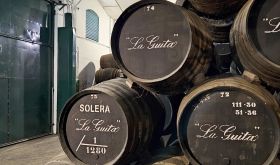This week of Live8 and the G8 summit it has, of course, to be an African wine. I scrolled through my notes on Namibian Ruby Cabernet and the produce of Ethiopia’s only winery, called Awash appropriately enough according to John and Erica Platter’s rollicking Africa Uncorked (Kyle Cathie, 2002), but finally settled on this South African wonder.
It is made, yet again I’m afraid, by the talented Marc Kent of Boekenhoutskloof (see a previous eulogy of his Porcupine Ridge Syrah and RSVP – Australia and against the rest of the world for comments on his top-of-the-range Syrah. The Chocolate Block 2003 Western Cape has been crafted to occupy the yawning price gap between these two. It’s a blend of just about everything Kent could get his hands on that was up to his exacting standards: Grenache from an old block in Citrusdal (not fancy wine country); Cabernet from Malmesbury; and Syrah, Cinsault and a hint of Viognier from Wellington. They were all fermented separately and then malolactic fermentation was left to happen spontaneously in used French oak casks, ex Boekenhoutskloof Syrah presumably. They were left on lees for 15 months before being blended, all with Master Marc’s Rhône Valley-informed touch. It’s called chocolate because it’s supposed to taste sweet and rich. I thought it tasted much less sweet than hundreds of other New World reds – but it is certainly rich in a Rhône cocktail sort of way – more Châteauneuf than Côte Rôtie. This wine is very nearly 15 per cent so has to be sipped gingerly, but the pH is not quite as worryingly high as that of the Porcupine Ridge 2003.
For a new, limited edition bottling, this wine is impressively well distributed around the globe, and the price varies considerably. Surely Brazil’s excellent importers Mistral are not really offering it for the equivalent of less than US$10 when the lowest price noted by winesearcher.com elsewhere is $24.99 at Union Square Wine & Spirits in New York and £15.99 at Handford Wine in London W11. It was available, I have to confess, at £14.99 at larger branches of Waitrose for a few weeks recently but that shipment has all gone, I’m told. Sorry not to have mentioned it earlier. Harvey Nix have it at £20.
Another fine South African red from carefully scouted vineyards is Flagstone’s Mary Le Bow 2004 Western Cape which is quite different, being based on Cabernet with some 25 per cent Syrah and 13 per cent Merlot. It is still youthful but has lots of sophisticated promise and has none of the aggressive acidity or harsh tannins of old-fashioned Cape reds. This is energetic and harmonious and has a comfortable 13.5 per cent alcohol.
According to winemaker Bruce Jack, “The Mary le Bow vineyards are situated in a staggeringly beautiful south-facing kloof high above Ashton, in the Robertson Area. Even if the soils were rubbish (which they are not) I would want to make wine from these grapes because they are in such a positive spot – full of good energy – some of it just has to find its way into the bottle.
“We pick the Merlot first, then the Shiraz and then the Cabernet from contiguous vineyards. The difference is that they all get de-stemmed into the same open-top fermenter (100 per cent manual punch down), and cold soak until the Cab arrives. In this way the grapes from specific, pre-determined rows are blended at the grape stage and we think this adds to the harmony of tannin. Big difference to the normal Flagstone style is that we are using really posh French barrels here.”
Because the blend contains some Merlot from another region, Tulbagh, it has to have the catch-all appellation Western Cape (the South African equivalent of South Eastern Australia). It seems to me a very grown-up wine indeed – as it should be for £18 a bottle when the Wine Society will be selling it in the UK, and is currently about £20 from Villeneuve Wines in Peebles, Scotland.
See http://www.flagstonewines.com/where.html for worldwide importers.













